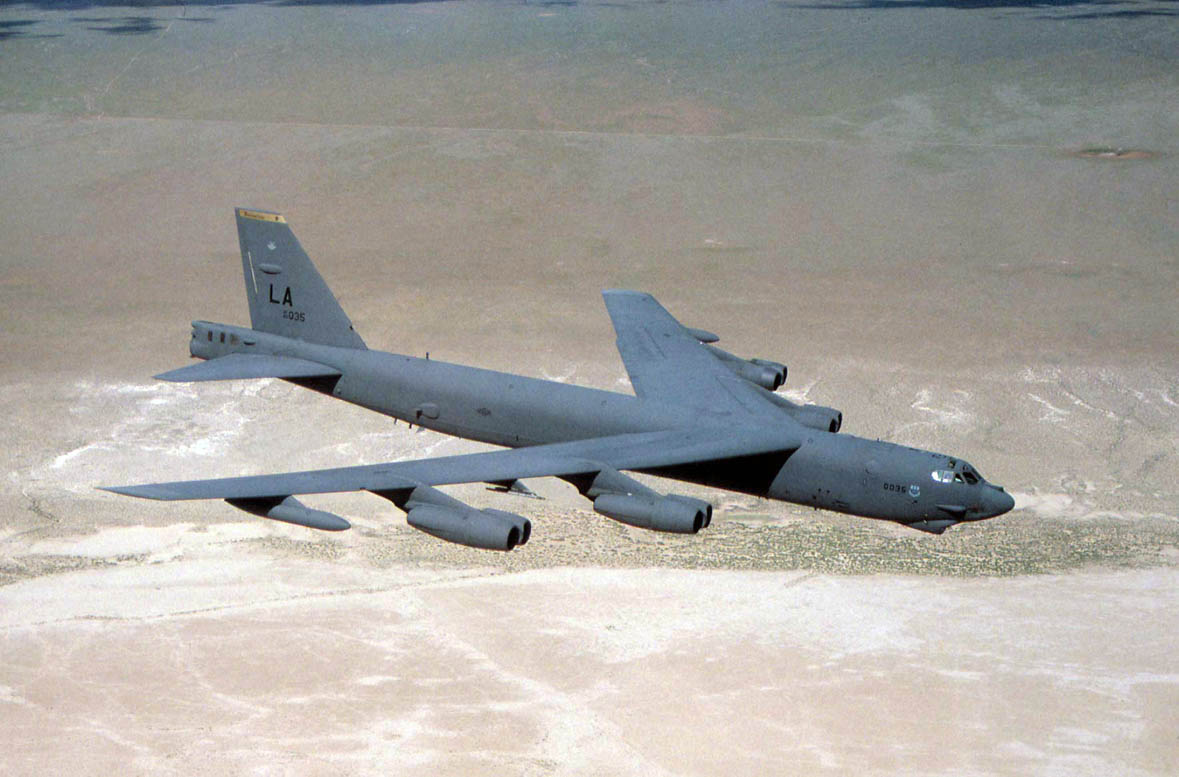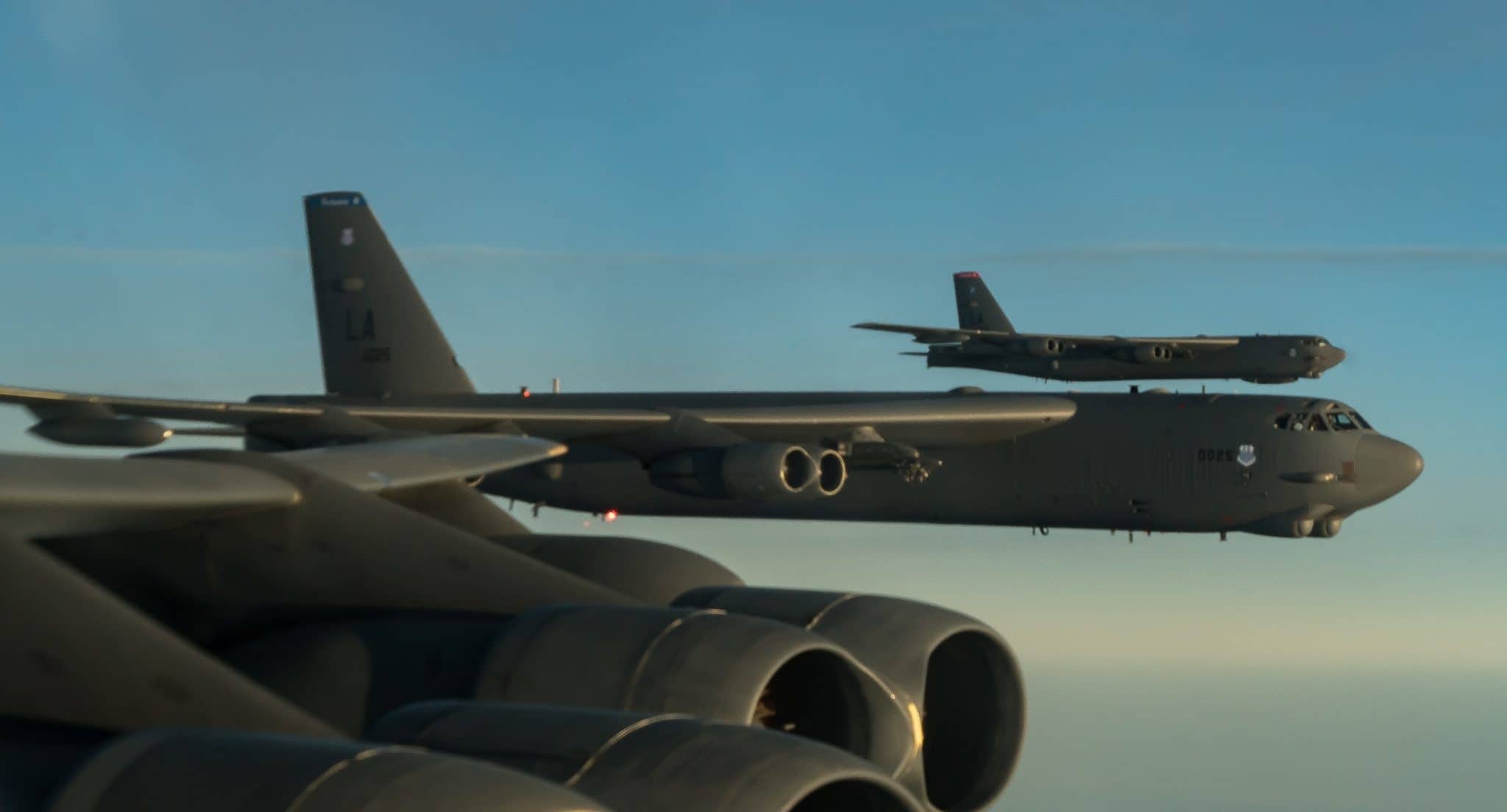Forecast: Stormy
B-52Gs from Barksdale AFB in Louisiana departed their CONUS base, attacked Iraqi targets, and recovered back at Barksdale. This mission covered 14,000 miles and took 35 hours to complete- a record at that time. B-52Gs also flew missions against Iraq from RAF Fairford in the United Kingdom, King Abdullah Air Base at Jeddah in Saudi Arabia, Morón Air Base in Spain, and from Diego Garcia in the Indian Ocean. The missions were flown at high altitude after the first three nights of sorties, but those initial three low-altitude missions were said to have a telling effect on Iraqi morale. B-52s flew about 1,620 sorties, and delivered 40% of the weapons dropped by coalition forces during Operation Desert Storm.

Modern War in a Relic
Two B-52Hs struck Baghdad power stations and communications facilities with 13 AGM-86C conventional air-launched cruise missiles (CALCMs). These BUFFs had departed Andersen AFB, Guam on 2 September 1996 and returned to recover at Andersen on 3 September. The mission covered 16,000 miles and took 34 hours to complete This Operation Desert Strike mission covered more distance than any other combat mission ever flown. During Operation Allied Force, B-52Hs took out Serb targets. During Operation Enduring Freedom, the B-52H was turned into a close air support (CAS) aircraft through the use of precision-guided munitions. Ten B-52Hs dropped a third of the total bomb tonnage delivered in Afghanistan. B-52s also performed missions during Operation Iraqi Freedom, delivering over 100 cruise missiles. BUFFs are still flying missions over Afghanistan as part of Operation Inherent Resolve. You’ll probably be reading about B-52Hs taking out targets in Syria sometime soon.

75 BUFFs Remain Today
Roughly 75 of the original B-52s produced still serve with the USAF. They are kept in the best shape possible by the USAF maintenance depot at Tinker AFB in Oklahoma and maintained at their Air Force Global Strike Command (AFGSC) bases in Minot AFB in North Dakota and Barksdale. A few B-52s are based at Edwards AFB in California for testing. B-52s are still viable weapons systems even though they are all older than their pilots. Well, most of them. There are third-generation BUFF pilots in the USAF pilot training pipeline as you read this, and it’s highly likely that there will fourth generation B-52 pilots before the venerable bomber is retired. B-52s cost less to operate than the B-2 Spirit bombers and have a higher mission-capable rate than either the B-1B Lancer or the B-2. Add to that the psychological value of a B-52 flying over places like Korea and the South China Sea these days and those 12 intact H models in storage still seem like good investments. There could have been more but…

So Long Golf
Every last one of the 365 B-52Gs remaining in service were destroyed after the fall of the Soviet Union. Peace Dividend? You decide. Those airframes could, and might have, come in handy had the nation been possessed of the foresight to see there was no viable replacement for them on any drawing board or rattling around in any defense contractor’s noggin. Yes, they were cut up into pieces at the Aerospace Maintenance and Regeneration Center (AMRC) in accordance with the terms of the Strategic Arms Reduction Treaty (START), but BUFF fans don’t have to like it. Perhaps the worst part is that the pieces were left to sit there so Soviet satellites could verify their carcasses were well and truly dismembered. What a shame!

Aging Movie Star
B-52s have starred in several movies. Bombers B-52 (Warner Brothers 1957), A Gathering of Eagles (Universal 1963), Doctor Strangelove or: How I Learned to Stop Worrying and Love the Bomb (Columbia 1964) and By Dawn’s Early Light (HBO 1990) all featured BUFFs in leading roles. Can you think of any more?


[…] loves the BUFF. Boeing’s B-52H Stratofortress is still a front line weapons system more than sixty years after it entered United States Air Force […]
I was stationed at Blytheville Air Force Base in the 70’s. I also spent two years in Guam. I refueled the BUFF and KC-135’s in both places. Everything you said was right on. the only thing I may want to say is Anderson was(in the 70’s) called Anderson Air Base (drop the word Force), as it was the only permanent SAC base outside CONUS at that time. I watched them take off and land everyday, as my job had me on the flight line every day.
Bill: Your review is one of the best I ever read. The only thing I would add is that, in total, 744 B-52’s of all models were built. I was an Air Policeman with the 379th Air Police Squadron working flightline security with the 379th Bomb Wing (Heavy) at Wurtsmith AFB, Oscoda, MI from Dec 63 to Aug 67. I love the Buff, despite freezing by butt off many a cold Michigan night guarding them. I will travel out of my way to see one in a museum. One of my biggest thrills was seeing a full on MITO with 8 B-52’s and 5 KC-135’s during an ORI exercise one year. I was at the take-off end of the runway and they peeled off right over me. I will never forget the noise, smoke and pure power of freedom.